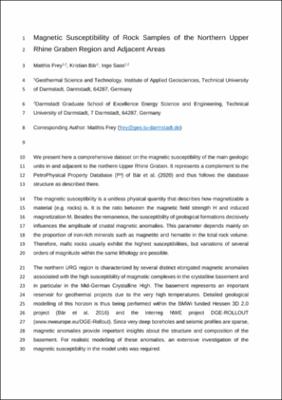| dc.contributor.author | Frey, Matthis | |
| dc.contributor.author | Bär, Kristian | |
| dc.contributor.author | Sass, Ingo | |
| dc.date.accessioned | 2020-12-22T08:01:47Z | |
| dc.date.available | 2020-12-22T08:01:47Z | |
| dc.date.issued | 2020-12 | |
| dc.identifier.uri | https://tudatalib.ulb.tu-darmstadt.de/handle/tudatalib/2551 | |
| dc.identifier.uri | https://doi.org/10.48328/tudatalib-393 | |
| dc.description | We present here a comprehensive dataset on the magnetic susceptibility of the main geologic units in and adjacent to the northern Upper Rhine Graben. It represents a complement to the PetroPhysical Property Database (P³) of Bär et al. (2020) and thus follows the database structure as described there.
The magnetic susceptibility is a unitless physical quantity that describes how magnetizable a material (e.g. rocks) is. It is the ratio between the magnetic field strength H and induced magnetization M. Besides the remanence, the susceptibility of geological formations decisively influences the amplitude of crustal magnetic anomalies. This parameter depends mainly on the proportion of iron-rich minerals such as magnetite and hematite in the total rock volume. Therefore, mafic rocks usually exhibit the highest susceptibilities, but variations of several orders of magnitude within the same lithology are possible.
The northern URG region is characterized by several distinct elongated magnetic anomalies associated with the high susceptibility of magmatic complexes in the crystalline basement and in particular in the Mid-German Crystalline High. The basement represents an important reservoir for geothermal projects due to the very high temperatures. Detailed geological modelling of this horizon is thus being performed within the BMWi funded Hessen 3D 2.0 project (Bär et al. 2016) and the Interreg NWE project DGE-ROLLOUT (www.nweurope.eu/DGE-Rollout). Since very deep boreholes and seismic profiles are sparse, magnetic anomalies provide important insights about the structure and composition of the basement. For realistic modelling of these anomalies, an extensive investigation of the magnetic susceptibility in the model units was required.
The analyzed rock samples, mostly derived from abandoned and active quarries as well as natural and other artificial outcrops, were provided by the Institut für Steinkonservierung Mainz e.V. The majority of the in total 430 samples were collected in the Odenwald. Additional sample locations are in the Saar-Nahe Basin, the Palatinate, the Vogelsberg and the Rhenish Massif. Apart from outcrop samples, the susceptibility was measured on 24 core plugs from the three wells Weiterstadt 1, Stockstadt 33R and Worms 3. The measurements were carried out at about 20 °C with the SM-30 handheld device from ZH instruments and were usually repeated three times for each sample, but the number may vary depending on the heterogeneity and size of the samples.
The results of the susceptibility measurements are shown in Fig. 1. The values range from about -2.4e-5 to 0.07 [SI]. The susceptibility of the post-Variscan units is generally very small, meaning that their effect on the crustal magnetic field can be neglected. This excludes the Permo-Carboniferous and Tertiary volcanic and volcano-sedimentary horizons, which are likely sources of stronger anomalies in the Saar-Nahe Basin, the northernmost URG and the Sprendlinger Horst. The highest susceptibility values were measured in gabbros of the Frankenstein complex.
The dataset is a supplement to another publication (Frey et al. 2020, subm.) that presents the results of the joint inversion of gravity and magnetic data in the northern Upper Rhine Graben. The measured magnetic susceptibilities were a key input for this study. | en_US |
| dc.language.iso | en | en_US |
| dc.rights | Creative Commons Attribution 4.0 | |
| dc.rights.uri | https://creativecommons.org/licenses/by/4.0/ | |
| dc.subject | Petrophysical Properties | en_US |
| dc.subject | Magnetic susceptibility | en_US |
| dc.subject | Upper Rhine Graben | en_US |
| dc.subject.classification | 3.44-01 Mineralogie, Petrologie und Geochemie | |
| dc.subject.classification | 3.43-01 Physik des Erdkörpers | |
| dc.subject.classification | 3.42-01 Geologie | |
| dc.subject.ddc | 550 | |
| dc.title | Magnetic Susceptibility of Rock Samples of the Northern Upper Rhine Graben Region and Adjacent Areas | en_US |
| dc.type | Dataset | en_US |
| dc.type | Text | en_US |
| dc.description.version | V1.0 | en_US |
| tud.unit | TUDa | |
| tud.history.classification | Version=2016-2020;314-01 Geologie, Ingenieurgeologie, Paläontologie;315-01 Physik des Erdkörpers;316-01 Organische und Anorganische Geochemie, Biogeochemie, Mineralogie, Petrologie, Kristallographie, Lagerstättenkunde; | |


